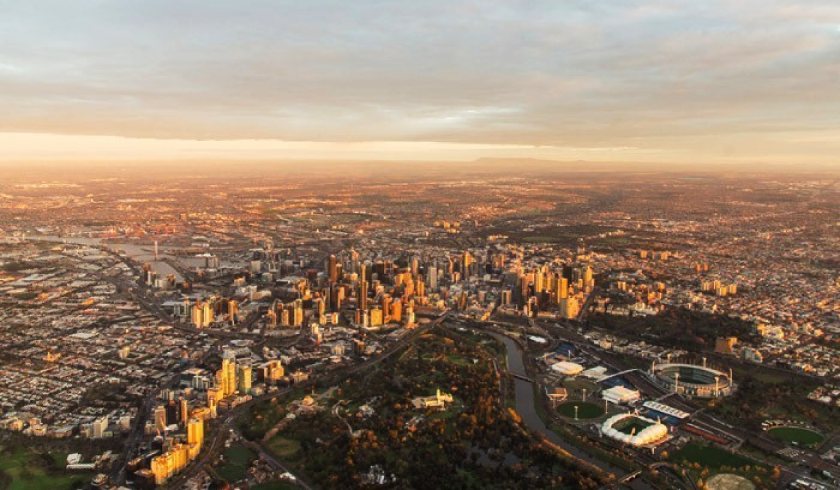Melbourne sees record-breaking growth despite Q3 lockdowns
Low financing costs, change in housing-type preferences due to flexible work arrangements, and government support for owner-occupiers have contributed to Melbourne’s record-breaking growth for 2021, according to a new study.

RPM’s Q3 Residential Market and Economic Review revealed that despite Melbourne being under harsh lockdown restrictions for much of the three-month period, strong residential property demand continued through September quarter 2021 with 6,445 auctions held, and a clearance rate of nearly 90 per cent.
According to RPM group manager for research and data Michael Staedler:
“The reduction in supply combined with high clearance rate suggests the presence of fierce competition among buyers for properties. The low borrowing costs and increased savings through the pandemic provided buyers with further ammunition to bid up prices, despite previous solid price growth already leading to the emergence of constrained affordability.”
Because of this, quarterly growth in the housing market has accelerated with the median price for both houses and apartments setting a new record high. However, the quarterly unit price increase was more modest, with inner-city unit markets remaining plagued by high vacancy rates due to the continued ban on foreigners entering Australia.
Sales in the September quarter of 2021 recorded a preliminary median house price of $1,072,500, which is a 6.0 per cent rise from the previous quarter and a sharp 24.8 per cent increase from $859,500 during the same quarter a year ago. Q3 also saw a unit price of $680,500, a lift of 0.4 per cent from the previous quarter and a 9.1 per cent rise from the same quarter a year ago.
With the inner ring as an exception, all rings of Melbourne have had positive home growth since June.
After reaching new highs, median prices fell 3.5 per cent to $1,704,500. Houses in the middle ring increased by 4.7 per cent to $1,264,500, while those in the outer ring increased by 1.8 per cent to $818,000.
The price of homes in all rings is still higher than a year ago, with inner-ring homes up 12.7 per cent and middle-ring homes up a massive 28.1 per cent.
Mr Staedler highlighted the strong performance of Regional Victoria, praising “its impressive price growth this quarter, continuing to outperform Metropolitan Melbourne in the unit market, although for the first time this year, houses have seen lower growth than Melbourne.”
Houses in Regional Victoria are now $570,000, while units are $394,500, representing rises of 2.4 per cent and 1.9 per cent over the previous quarter.
When comparing current area prices to a year ago, homes are up 28.2 per cent, while units are up 19.2 per cent. The prevalence of work from home options has aided Regional Victoria's sustained price development, allowing people to prioritize lifestyle homes and an increase in demand for additional land.
The higher demand for land is reflected in a 2.5 per cent hike of the preliminary median land price for the September quarter of 2021 to $326,000 from the previous quarter, and 6.7 per cent from the same quarter a year prior.
RPM’s research and data group manager has noted the relative affordability advantage of new homes in growth areas which has expanded as vacant lot prices have grown at a slower rate than the existing housing market.
“This increases attractiveness of new homes in greenfield areas as more people are priced out of established markets, and provides some prospects for solid lot price growth to continue through late 2021 and into 2022, notwithstanding the greater serviceability test on new home loan applicants that may reduce the borrowing capacity for future purchasers,” he said.
Emerging trends
Daniel Gradwell, economist at ANZ, has concurred with Mr Staedler while weighing in on the impact of the HomeBuilder grant’s conclusion:
“The greenfield sector and detached housing have been driving significant growth, but with the removal of key accelerator initiative HomeBuilder, we’ve seen approvals drop off. Now a new trend is emerging, with units and apartments approvals starting to pick up.”
Unit and apartment approvals in the September quarter were nearly double the cycle low for the 2020/21 new year period, Mr Gradwell shared.
Although Mr Gradwell admitted that this hasn't yet translated into construction activity, he opined it's certainly encouraging for the industry as a whole and has led to some fascinating dynamics arising inside the units and apartments industry.
“Over the last few years, high density (four or more storeys) has represented around 50-60 per cent of unit and apartment approvals, with townhomes around 40 per cent. Now the tables have turned, with townhomes representing near 60 per cent, demonstrating the product is currently hitting a sweet spot for a variety of buyers, given its relative affordability, potential for prime locale and more space than an apartment,” he explained.
The townhome product's popularity has obviously been aided by the societal shift toward working from home, which may now be a permanent reality for a lot of buyers, Mr Gradwell added.
The RPM report, likewise, has recognised the effect of pausing inspections on townhouse sales, but pointed out that townhouses are more common in Melbourne's middle and outer rings, and thus, less subject to changing preferences aligned with working situations.
Moreover, in comparison to the badly impacted inner-ring CBD apartments, medium-density products and boutique, low-rise flats, both of which maintain a substantially higher share of owner-occupier products, have generally carried the unit market, which has around two thirds of stock classified as investment properties.
As a result, unit prices in Metropolitan Melbourne have only increased by 0.37 per cent, from a median of $678,000 in June quarter 2021 to $680,500 in September quarter 2021.
Moving to the apartment market in Melbourne, the study has shown that its growth was constrained this quarter due to rolling lockdowns, which pushed buyers outside the CBD and into lifestyle property possibilities.
“Inner ring unit prices have dropped very slightly (0.08 per cent) over the quarter, but interestingly, while sales activity has stagnated, vacancy rates have fallen in the inner ring to 5.8 per cent at the end of September – although still slightly higher than the two-year average, it’s a significant drop from 7.6 per cent at the end of June 2021,” the report said.
Economic and property outlook
RPM’s report has predicted rising business confidence and conditions, with ANZ’s employment advertising citing an almost 20 per cent increase in advertised vacancies compared to pre-pandemic levels.
Another trend that has been spotted by the RPM research is investors returning to the real estate market, although this appears to be at the price of first-time purchasers.
While conditions for first-time buyers have been ideal for the past year or so credited to the HomeBuilder grant, stamp duty incentives, and stimulus programs, investors are now outnumbering first-time buyers as the climate shifts, and researchers at RPM opined it's unlikely that conditions will entice more first-time buyers into the market for some time.
“Investors are now surpassing first home buyers, with investors dropping to a low point of 21 per cent of housing finance last year, but strengthening to 31 per cent this quarter, with first home buyers dropping from 30 per cent to just 19 per cent,” the study revealed.
As it stands, where is Melbourne’s property market headed?
Mr Staedler pointed out that although the home price in Victoria’s capital peaked in March at 2.1 per cent, it has since slowed to 0.7 per cent in October, which, although still significant, indicates that the biggest pricing increases will not be sustained.
Here’s why:
RPM’s data and research group manager expounded that as we approach a post-pandemic economy, there are two main reasons driving property market expansion.
1. Macroprudential regulation
Looking back, Mr Staedler cited the recent Australian Prudential Regulation Authority (APRA) move that changed serviceability calculations from 2.5 per cent to 3 per cent.
“Given the majority don’t borrow to their capacity, and this change reduces borrowing power by only around 5 per cent, this is not a significant change in isolation. However, it provides a clear signal that we are likely to see more changes over the coming months if prices keep rising, and it may start to take some heat out of the property market.”
2. Interest rates
Although the economic outlook is on the bright side, Mr Staedler has put out a word of caution for those in the property market:
“While there’s been no major shift yet, it’s important to note that it’s coming, with fixed rates bottoming in February and climbing ever since. This is encouraging from an economic standpoint, because fundamentally, it means the economy is performing well.
“But there are some negative connotations for the housing market, which benefited from low interest rates for the past 18 months.”
